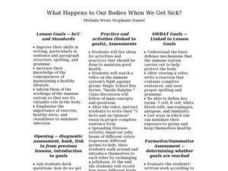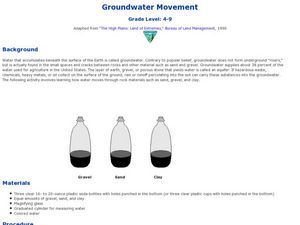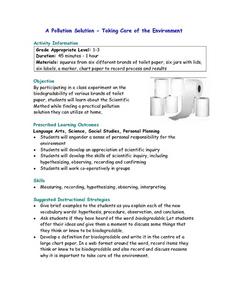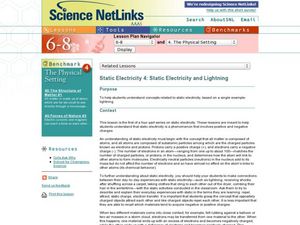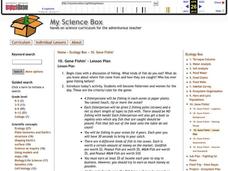Curated OER
Flour Beetle
Students observe the life cycle of the common flour beetle and make observations of its life stages. They also design and implement an investigation on food preference for the beetle and record data over a period of several months....
Curated OER
What Happens to Our Bodies When We Get Sick?
Seventh graders explore ways in which they become sick. They find out ways that there bodies fight off bacteria. Students watch a video from the Magic School Bus series:"Inside Raphie." After reviewing video students can openly discuss...
Curated OER
What is a Seed?
Students share experiences they have had with different types of seeds. After being read a story, they are given a lima bean in which they split apart and examine the inside. To end the lesson, they share their own ideas on how they...
Curated OER
Stator limbatus Study, Part 1
Second graders experiment identifying beetle emergence and exit holes in seeds, count them, look for beetle eggs with a magnifier and count how many beetle eggs they find. They then graph on a data sheet the findings from their research.
Curated OER
Ocean Streams
The instructions for demonstrating ocean turnover are provided in this resource. You could set this up for your earth science class as part of a lecture on convection currents or as an explanation of how ocean currents form. An animation...
Curated OER
Kernels of Wisdom: Investigating Natural Variations in Corn
Here is a brain-popper! Corn, or more appropriately, maize, was intentionally domesticated by humans around 9,000 years ago and over a period of hundreds to thousands of years! Genetics and botany researchers have collaborated to find...
Curated OER
Physical Changes and States of Matter
Fourth graders identify a physical change as one that results in a change in size, shape, or state of matter. After an initial teacher-led discussion and demonstration, groups of students get together to perform an experiment which...
Curated OER
Picture Yourself in an Ornament
Students create an ornament with their photo inside of it. To create the personal memento, students observe demonstrations and follow directions. Students experience making a craft and giving the memento to a family member.
Curated OER
What Are You Eating?
Discover the calorie content of foods by observing how much heat they produce in water. If you have a calculator-based laboratory (CBL™) insturment for collecting data, then this laboratory worksheet will not need any changes. If...
Curated OER
Cloning a Living Organism
It's the attack of the clones! Not to worry; these are just plant clones. Teen horticulturalists will enjoy growing their own clone into a plant in an activity designed to be revisited after a few weeks. It is one experiment that kids...
Curated OER
Groundwater Movement
Students study groundwater movement beneath the surface of the Earth. In this agriculture lesson, students experiment with how water moves through rock materials such as sand, gravel, and clay.
Curated OER
Testing Leaves for Starch: the Technique
Like good scientists, kids often want to see first-hand why things are as they are; they can do just that in the starch-testing photosynthesis activity found here. Depending on the age of your pupils, you may wish to do the investigation...
Curated OER
Activity Plan 4-5: Opposites Attract!
Students experiment with magnets and sort objects based on magnetism. In this hands-on physical science activity, the children are introduced to magnetism through discussion and experimentation and have the opportunity to use different...
Alabama Learning Exchange
Air is All Around You
Pupils investigate the mysteries of air. In this science lesson plan, learners participate in hands-on activities that require them to use the scientific inquiry model to study air.
Curated OER
Salty Sea Water
Learners conduct an experiment to find out if there is salt in the ocean. In this scientific inquiry lesson, students pour a cup of salt water onto an aluminum plate and observe the changes over a few days. Learners complete an included...
Curated OER
A Pollution Solution- Taking Care of the Environment
Students examine the biodegradability of different brands of toilet paper in a hands-on activity. Through this activity they also discover the steps of the Scientific Method and use new terms such as hypothesis, procedure, observation,...
Curated OER
Amazing Water Changes
Students explore the properties of water and how it changes states. In this kindergarten to 2nd grade science lesson, students pair a hands-on science activity with two suggested books. This inquiry lesson has...
Curated OER
Gone Fishin'
Students experiment with population management in this hands-on lesson. In this biology lesson, students collect data on overuse of a resource and how to manage for sustainability. Students fish for m&m's using...
Curated OER
Fighting Soil Erosion
Students complete hands-on activities and watch a video to learn about soil erosion. In this erosion instructional activity, students use hands-on studies to investigate soil erosion. Students then visit the given websites to identify...
Curated OER
Toothpick Worms
Students investigate camouflage. For this science lesson plan, students experience the role of color in camouflage as they complete a hands-on activity.
Curated OER
Baseball Activity: Bouncing Balls
Students explore the concept of motion. In this hands-on physics instructional activity, students examine how the construction of baseballs and the temperature they are stored at affect their bounce.
Curated OER
Activity Plan Mixed Ages: Sunny Science
Students develop problem-solving, observation, and critical-thinking skills. For this early childhood lesson, students explore the topic of the sun as they notice shadows and light.
Curated OER
Hatching Chickens
Students discover how chickens are hatched and cared for. In this hands on lesson students get to watch baby chicks be hatched. They explore the chicks needs and how long they take to hatch.
Curated OER
Treasure Hunt
Students actively search a the ground outside and find several types of leaves, lichen, feathers and trash. They place items into journals, write entries, draw pictures and ask questions about the items found on their exploration.

